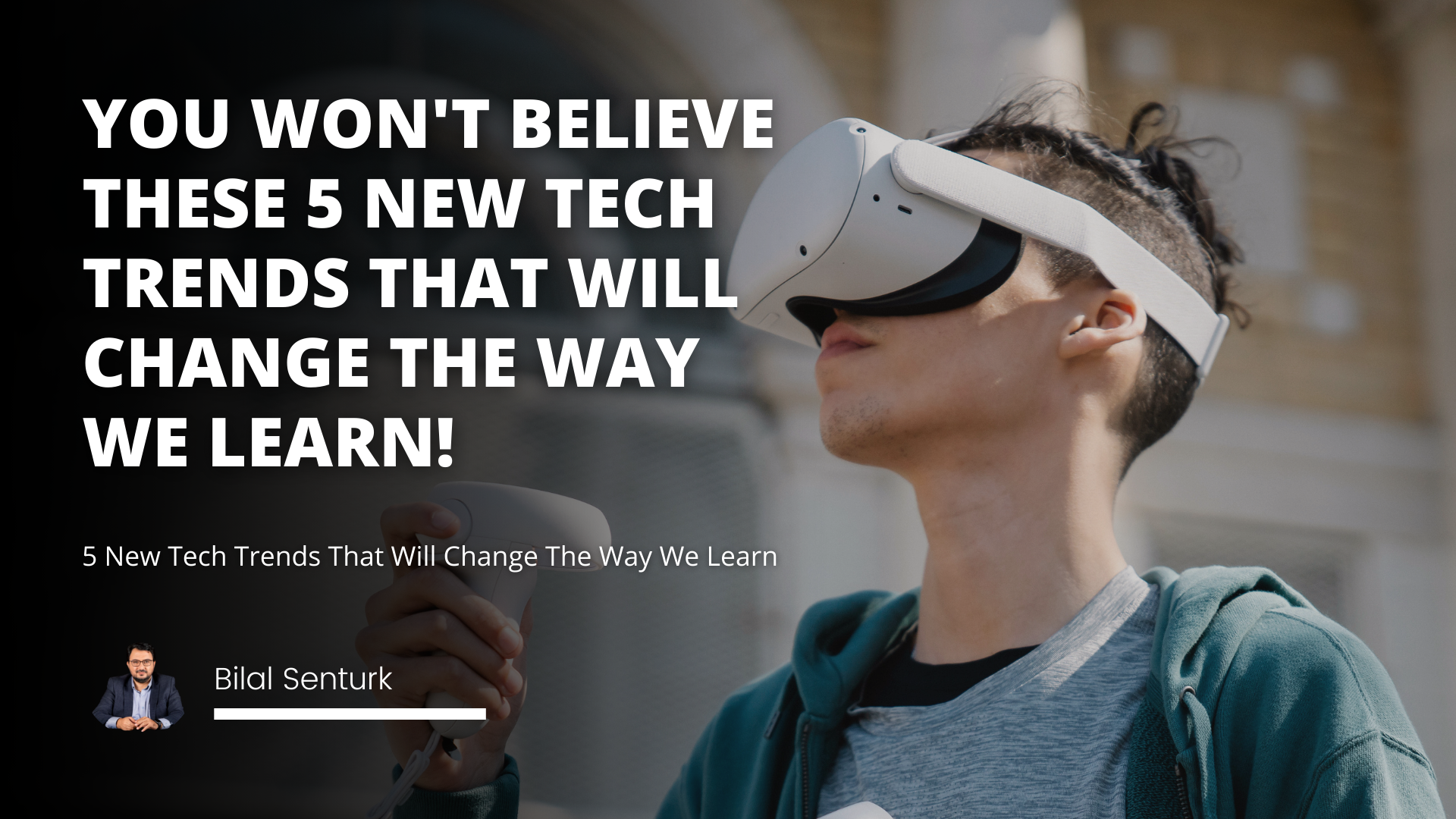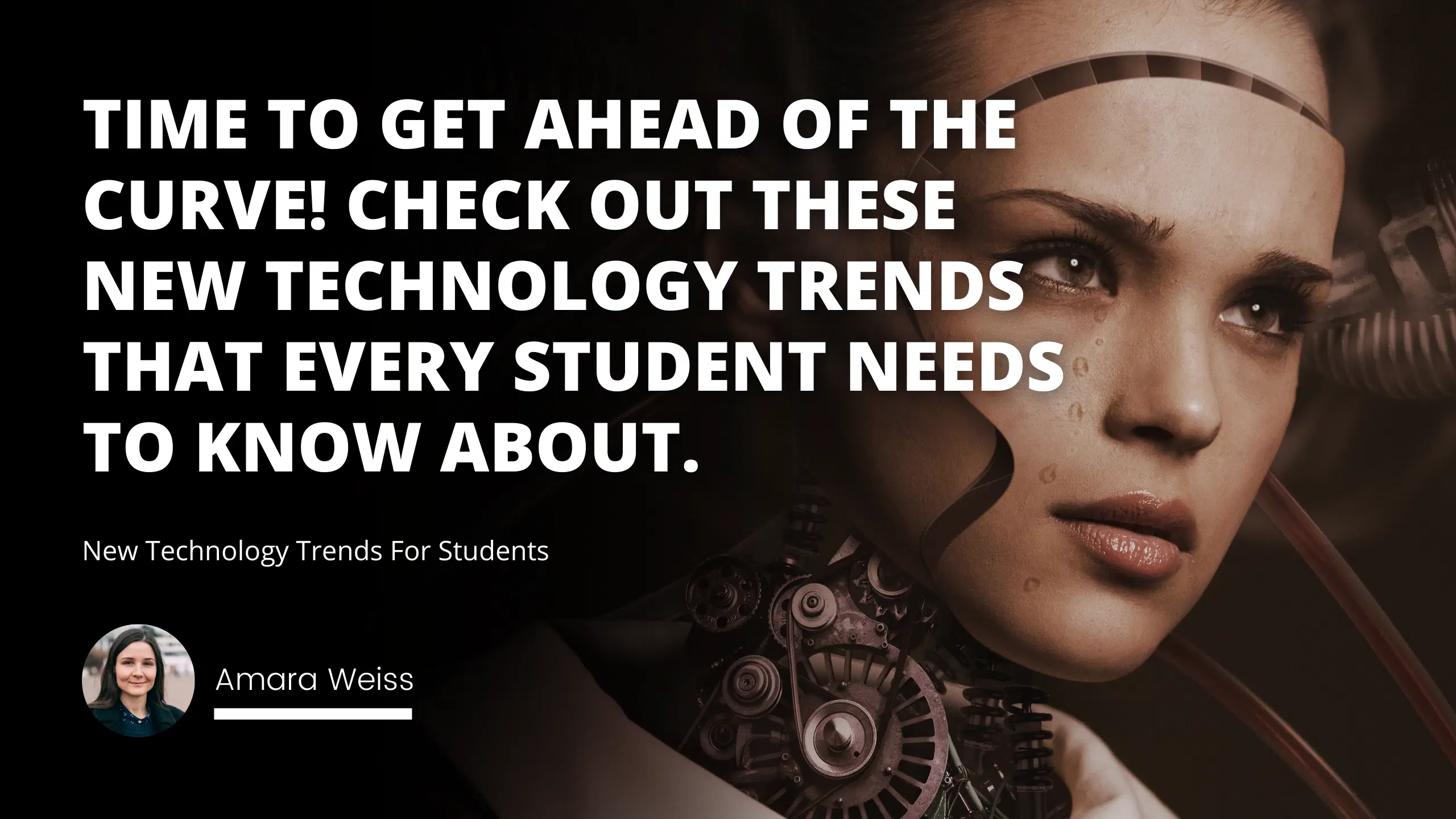
As students, we always look for ways to improve our learning experience. Whether through new technology or different methods of studying, we are always searching for ways to make the process easier and more efficient. This blog post will discuss some of the latest technology trends that can benefit students. Keep reading to learn more!
The latest and greatest in tech for students
New technology is constantly emerging, and it can be hard to keep up with the latest trends. However, staying on top of the latest technology is essential for students. After all, many of the tools that students use daily are powered by technology. From laptops and tablets to phones and e-readers, new tech is constantly changing how students learn and interact with the world around them.
Forecasted expenditure on advanced education technology worldwide from 2018 to 2025 (in billion US dollars)
The global expenditure on EdTech is expected to rise sharply in the next few years, with particularly strong growth in the area of augmented and virtual reality. Between 2018 and 2025, spending is forecast to increase from 1.8 billion US dollars to 12.6 billion US dollars. This trend is being driven by the increasing use of EdTech in higher education, as well as by the falling costs of hardware and software.
Artificial intelligence is another area where EdTech expenditures are expected to grow rapidly, rising from 0.8 billion US dollars in 2018 to 6.1 billion US dollars in 2025. This growth is being driven by the increasing use of AI-powered applications such as chatbots and learning analytics tools. Robotics is another area where EdTech is seeing rapid growth, with expenditures forecast to increase from 1.3 billion US dollars in 2018 to 3.1 billion US dollars in 2025.
This trend is being driven by the increasing use of robots for teaching and learning tasks such as lab demonstrations and assessment tasks.
So, what are some of the latest and greatest tech trends for students? Here are a few to keep an eye on:
Augmented and virtual reality
Augmented reality (AR) and virtual reality (VR) are two technologies quickly gaining popularity. AR allows users to overlay digital information on the natural world, while VR transports users into a completely simulated environment. Both technologies have great potential for students. For example, AR could provide real-time translations in foreign language classes, while VR could take students on virtual field trips to places they might not otherwise be able to visit.
Technology implementation in online education programs in Russia 2020
Share of online educational programs using new technologies in Russia in 2020, by category
Why AR and VR are perfect for students
Augmented and virtual reality are becoming increasingly popular, and for a good reason. These immersive technologies have a wide range of potential applications, from gaming and entertainment to education and training. Regarding learning, AR and VR offer several advantages over traditional methods. For one, they can provide a more immersive and engaging experience. For example, students can be transported to other worlds or recreate historical events, making the material easier to understand and remember. Additionally, AR and VR can be used to create simulations that allow students to practice skills in a low-risk environment. As these technologies continue to develop, they will likely play an increasingly important role in education.
The Benefits of AR and VR for Students
Top XR/AR/VR/MR applications in the education sector as per U.S. XR experts 2020Leading applications of immersive technologies in the education sector in the next two years according to XR/AR/VR/MR industry experts in the United States in 2020
AR and VR offer several advantages for students. These immersive technologies can provide a more engaging and immersive learning experience, making it easier for students to understand and remember the material. Additionally, AR and VR can be used to create simulations that allow students to practice skills in a low-risk environment. As these technologies continue to develop, they will likely play an increasingly important role in education.
7 Ways Augmented Reality Will Change Your Life as a Student
Augmented reality (AR) is a technology that overlays computer-generated images on top of the real world. It has been used extensively in video games, but its potential goes far beyond entertainment. Here are seven ways AR could change your life as a student:
Augmented reality can provide real-time feedback on assignments. For example, if you're working on a math problem, an AR app could show you the steps you need to take to solve it.
Augmented reality can be used for visual and auditory note-taking. For example, you could use AR to record a lecture and add your notes and comments to the recording.
Augmented reality can be used for research projects. For example, if you're studying a historical event, you could use AR to overlay information about the event onto the natural world around you.
Augmented reality can be used for studying anatomy. For example, you could use AR to place labels on bones or organs so that you can see what they're called and how they fit together.
Augmented reality can be used for foreign language learning. For example, you could use AR to display translations of words and phrases in real-time as you hear them.
Augmented reality can be used for navigation. For example, you could use AR to display walking directions to your next class or the location of your dorm room on a campus map.
Augmented reality can be used for entertainment. For example, you could use AR to play games or view movies in an immersive environment.
Why students should be excited about augmented reality
These technologies offer students a new way to learn and engage with the material. Augmented reality, in particular, has the potential to revolutionize education. With augmented reality, students can immerse themselves in a given topic and experience it firsthand. For example, if they study the Civil War, they can use augmented reality to visit actual battlefields and see what life was like for soldiers at that time. Augmented reality can also be used to bring fictional worlds to life – imagine being able to step into your favorite book or movie and explore it firsthand. The possibilities are endless, and students should be excited about augmented reality's role in their education.
Drones
Drones are another emerging technology with lots of potential for students. These uncrewed aerial vehicles (UAVs) can be used for everything from photography and videography to data collection and mapping. Drones can also be used for educational purposes such as giving students a bird's-eye view of their school campus or local community.
The use of drones in the education sector has grown rapidly in recent years, with a range of applications being used to assist in mapping and surveying, inspection, localization and detection. In 2021, it was measured that 53% of drone use was for mapping and surveying, 18% for inspection, 12% for localization and detection, and the remaining 17% for other applications. The benefits of drone use in the education sector are endless; it saves time and money compared to traditional methods, while also providing a more efficient and effective way of accomplishing specific tasks. As technology continues to evolve, the use of drones in the education sector is expected to continue to increase.
Breakdown of drone usage in the educational services industry worldwide in 2021, by application
The potential of drones in education
The potential of drones in education is high. New technology trends for students can bring different perspectives to the classroom and motivate some students. The use of drones can provide a new way to view the world from a different perspective. Drones can help with mapping projects, allow for aerial photography, and even help with Three-dimensional (3D) printing. In the classroom, drones can also be used to teach principles of science, technology, engineering, and mathematics (STEM). For example, a drone can demonstrate how wind affects objects in motion or how an airplane flies. In addition, drones can be used to inspire creativity and problem-solving skills. For example, students could use a drone to create a video or take photos of their school from a new perspective. With the proper guidance, the potential of drones in education is excellent.
5 Ways Drones Can Be Used in Education
1. For photography and videography
2. For data collection and mapping
3. For aerial inspections
4. For delivery of educational materials
5. For STEM education
How Drones Are Changing the Way, We Learn
Drones are becoming increasingly popular, both for recreation and commercial use. And as drone technology continues to evolve, it's also changing how we learn. New apps and online platforms are making it easier for students to get started with drones, allowing them to explore new perspectives and gain hands-on experience with the latest technology trends. From using drones to capture aerial footage of historical landmarks to using them to study animal behavior in the wild, there are endless opportunities for students to use drones to expand their horizons. And as drones become more mainstream, they're likely to have an even more significant impact on education in the years to come.
Robotics
Robotics is another growing area of interest for students. Robotics kits, like the famous LEGO Mindstorms line, allow students to build and program their robots. These projects can teach students everything from engineering and programming to mathematics and physics. Plus, they're just plain fun!
Why students should be interested in robotics
As new technology trends evolve, students must keep up-to-date on the latest advancements. Robotics is one area that has seen significant growth in recent years and is expected to continue to rise in popularity. Here are a few reasons why students should be interested in robotics:
1. Robotics offers a unique blend of engineering and programming.
2. Robotics competitions are a great way to meet other students with similar interests.
3. Robotics can lead to exciting career opportunities in various industries.
As technology becomes increasingly important in our world, students need to understand how it works. For those interested in pursuing a career in science or engineering, robotics is a great way to gain experience with the latest technology trends.
The Benefits of Robotics In Education
Robotics has revolutionized the field of education. By providing students with a hands-on way to learn about science, technology, engineering, and math (STEM), robotics programs have helped to increase interest in these disciplines. In addition, robotics can help to improve problem-solving and critical thinking skills. Therefore, as educational institutions continue to adopt robotics programs, they must consider their benefits.
One of the critical benefits of robotics in education is that it can help to increase interest in STEM disciplines. Robotics provides a concrete way for students to engage with complex concepts in science and math. They develop a deeper understanding of these subjects as they work on programming their robots. In addition, robotics can also help to give students a better appreciation for technology and engineering. Seeing how these disciplines are used in everyday life, they may be more likely to pursue careers in these fields.
Another benefit of robotics in education is that it can help to improve problem-solving and critical thinking skills. As students work on programming their robots, they must figure out how to overcome challenges and obstacles. This process requires them to think creatively and come up with innovative solutions. In addition, working with robots also requires students to use strong critical thinking.
Case studies: How robotics are being used in different fields
Robotics is increasingly being used in various fields, from medicine to manufacturing. One recent example is the use of robotics in surgery. In 2016, surgeons in France used a robot to perform a double hand transplant on a patient who had lost both hands in an accident. The robot was equipped with special tools that allowed the surgeons to work with greater precision than they could have with their bare hands. Another example of the use of robotics is in the field of prosthetics. Researchers at ETH Zurich have developed a robotic arm that thoughts can control. The component is fitted with sensors that read brain signals and translate them into commands that move the arm. The aim is to provide amputees with a more natural and efficient way to control their prosthetic limbs. Robotics is also being used in the automotive industry. BMW has been using robots to paint cars for more than 25 years. The robotic paint spraying system applies paint evenly and consistently, producing a high-quality finish. This example shows how robotics can improve productivity and quality control in manufacturing.
3D printing
3D printing is yet another technology that is becoming more accessible to students. This additive manufacturing process allows users to create three-dimensional objects from digital models. 3D printers are becoming increasingly common in schools and libraries, making it easier for students to get their hands on this cutting-edge technology.
Why 3D printing is becoming increasingly popular in schools
There are several reasons why 3D printing is becoming more popular in schools. One reason is that it can help to increase interest in STEM disciplines. 3D printing provides a concrete way for students to engage with complex concepts in science and math. As they work to design and print their 3D objects, they develop a deeper understanding of these subjects. In addition, 3D printing can also help to give students a better appreciation for technology and engineering. Seeing how these disciplines are used in everyday life, they may be more likely to pursue careers in these fields.
Another reason 3D printing is becoming more popular in schools is that it can help improve problem-solving and critical thinking skills. As students work on designing and printing their 3D objects, they must figure out how to overcome challenges and obstacles. This process requires them to think creatively and come up with innovative solutions. In addition, working with 3D printers also requires students to use strong critical thinking skills.
Why 3D printing is a game-changer for education
3D printing is a game-changer for education because it can completely transform the way students learn. With 3D printing, students can create their learning materials. They can also design and print objects that they can use to illustrate concepts that they are studying. In addition, 3D printing can also help to improve problem-solving and critical thinking skills. As students work on designing and printing their 3D objects, they must figure out how to overcome challenges and obstacles. This process requires them to think creatively and come up with innovative solutions. In addition, working with 3D printers also requires students to use strong critical thinking skills. Ultimately, 3D printing provides a more interactive and hands-on way for students to learn. And as more schools adopt this technology, we can expect to see a significant shift in how education is delivered.
How easy is it for students to use 3D printers?
3D printers are becoming increasingly easy to use, thanks to technological advances. Many of the newer 3D printers on the market come with user-friendly software that makes it easy for even beginner users to get started. In addition, there are now many online resources that provide step-by-step instructions for using 3D printers. As 3D printing technology continues to evolve, we can expect to see even more user-friendly 3D printers accessible to students of all ages.
Wearable technology
Wearable technology, such as smartwatches and fitness trackers, is becoming more popular with students. These devices can track everything from fitness data to school assignments. Additionally, many wearables now offer features like GPS tracking and mobile payment options, making them even more helpful for students.
The Benefits of Wearable Technology for Students
Wearable technology has the potential to revolutionize the way that students learn. By providing a more immersive and hands-on experience, wearable tech can help students retain information and develop a deeper understanding of concepts. In addition, wearable tech can provide immediate feedback on student performance, allowing them to quickly identify areas where they need improvement. Perhaps most importantly, wearable tech can help to increase engagement and motivation by making learning more interactive and fun. As wearable technology becomes more sophisticated and affordable, it will impact education profoundly.
How wearable technology is changing the way students learn
Wearable technology is changing the way students learn in several ways. First, by providing a more immersive and hands-on experience, wearable tech can help students better retain information and develop a deeper understanding of concepts. In addition, wearable tech can provide immediate feedback on student performance, allowing them to quickly identify areas where they need improvement. Perhaps most importantly, wearable tech can help to increase engagement and motivation by making learning more interactive and fun. As wearable technology becomes more sophisticated and affordable, it will impact education profoundly.
The Top 5 Wearable Tech Devices for Students
1. Apple Watch
2. Fitbit
3. Garmin
4. Samsung Gear
5. Xiaomi Mi Band
Each of these wearable tech devices offers unique features that can benefit students. For example, the Apple Watch includes a built-in heart rate monitor and fitness tracker, while the Fitbit has a sleep tracking feature that can help students get a good night's sleep. The Garmin also includes GPS tracking, which can be helpful for students involved in after-school activities or sports. Ultimately, any of these wearable tech devices can help students improve their academic performance by making learning more interactive and fun.
Internet of Things
The Internet of Things (IoT) refers to the growing network of physical objects connected to the internet. This includes everything from appliances and vehicles to wearable devices and home security systems. For students, the IoT can provide a wealth of information and resources. For example, smart thermostats can help save energy and money, while connected security cameras can provide an extra layer of safety.
The Benefits of the Internet of Things for Students
With the Internet of Things, students can have greater access to resources and information than ever. The Internet of Things refers to the interconnectedness of physical objects and devices that can share data and communicate. This network can be used to increase efficiency and productivity in a variety of settings, including schools. For example, teachers can use the Internet of Things to monitor classroom climate and energy usage in real-time, allowing them to make adjustments as needed. In addition, the Internet of Things can provide students with customized learning experiences. By tracking data related to student performance, educators can identify areas of weakness and adjust their instruction accordingly. As the Internet of Things becomes more widespread, its potential to transform education will only continue to grow.
How the Internet of Things is transforming education
The Internet of Things is profoundly impacting education, providing teachers with new resources and ways to improve student learning. The Internet of Things refers to the interconnectedness of physical objects and devices that can share data and communicate. This network can be used to increase efficiency and productivity in a variety of settings, including schools. For example, teachers can use the Internet of Things to monitor classroom climate and energy usage in real-time, allowing them to make adjustments as needed. In addition, the Internet of Things can provide students with customized learning experiences. By tracking data related to student performance, educators can identify areas of weakness and adjust their instruction accordingly. As the Internet of Things becomes more widespread, its potential to transform education will only continue to grow.
The many applications of the Internet of Things for students
The Internet of Things can be used in various ways to improve student learning. For example, smart thermostats can help save energy and money, while connected security cameras can provide an extra layer of safety. In addition, the Internet of Things can provide students with customized learning experiences. By tracking data related to student performance, educators can identify areas of weakness and adjust their instruction accordingly. As the Internet of Things becomes more widespread, its potential to transform education will only continue to grow.
As you can see, there are many significant new tech trends for students to be excited about. These emerging technologies can revolutionize how we learn and interact with the world around us. So, whether you're a student or know someone who is, be sure to keep an eye out for these exciting new trends!

Frequently Asked Questions
Do you think that new technologies like artificial intelligence and virtual reality will be used in schools more often in the future?
As our world becomes increasingly reliant on technology, it is inevitable that new technologies will find their way into the classroom. Artificial intelligence and virtual reality are two of the most promising new technologies with potential applications in education. Artificial intelligence can be used to create personalized learning experiences for students and to provide educators with valuable insights into student progress. Virtual reality, meanwhile, can be used to transport students to different places and times, providing them with a richer and more immersive learning experience. It is likely that both artificial intelligence and virtual reality will play a role in education in the years to come.
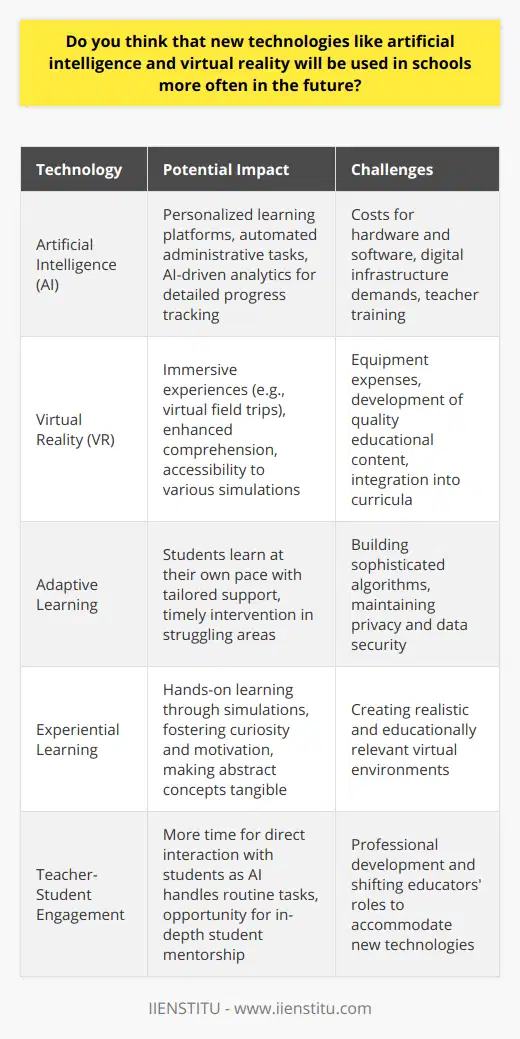
Are there any other new technologies that you think will be important for students to learn about?
While it is impossible to predict which technologies will emerge in the coming years, there are a few that seem particularly promising for students. One is virtual reality, which has already begun to be used in classrooms as a way to enhance learning. For example, students can use VR headsets to explore historical sites or get an up-close look at the human body. As VR technology advances, it is likely that more and more schools will make use of it. Another potentially important technology is artificial intelligence. AI can be used for tasks such as grading essays or providing personalized feedback on assignments. In the future, AI may even be able to teach entire classes on its own. As these and other technologies continue to develop, it is important for students to stay up-to-date on the latest advancements.
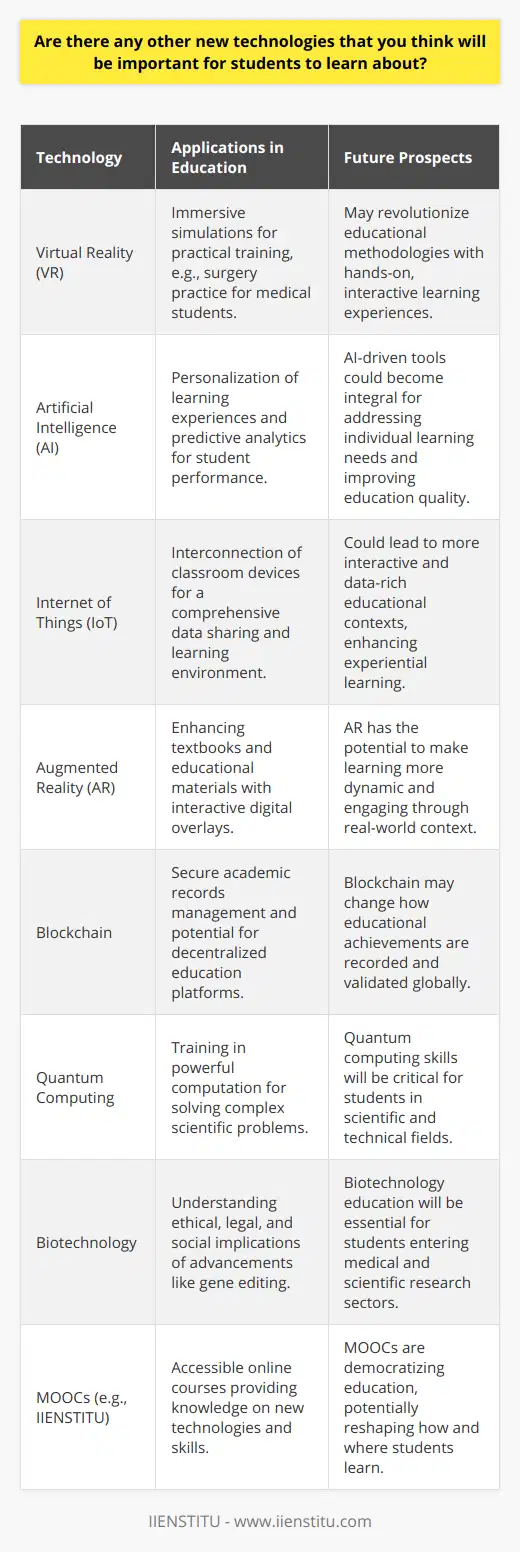
How do you think schools should prepare students for a world where new technologies are constantly evolving?
In a world where new technologies are constantly evolving, it is essential for schools to prepare students for the ever-changing landscape of the workforce. While some may argue that schools should focus on teaching students the basics that will always be relevant, such as reading, writing, and math, others contend that schools should place greater emphasis on teaching students how to use new technologies. Personally, I believe that schools should strike a balance between these two approaches. On one hand, it is important for students to learn the basics that will always be relevant. After all, these are the skills that students will use every day in their personal and professional lives. However, it is also important for students to learn how to use new technologies. After all, the workforce is constantly changing, and employers are increasingly looking for employees who are comfortable with new technologies. As a result, I believe that schools should focus on both teaching students the basics and preparing them for a world where new technologies are constantly evolving.
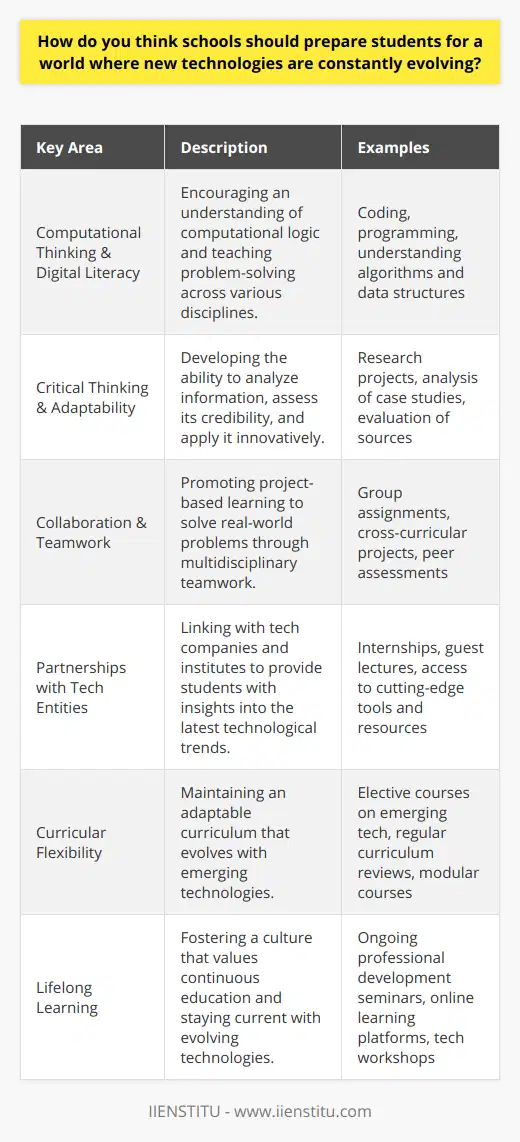
What is the most used technology in school today?
Introduction
The present academic landscape massively uses technology. The predominant technology today appears to be Interactive Whiteboards (IWBs), Learning Analytics (LA), and Learning Management Systems (LMS).
Interactive Whiteboards (IWBs)
IWBs are common in classrooms today. Students interact directly with the board, enhancing their learning experience. Tasks involve showing videos, making illustrative diagrams, or interactive quizzes. This tool stimulates students' participation and collaboration, promoting a dynamic academic environment.
Learning Analytics (LA)
LA is a key technology in modern schools. It is a method of using educational data to improve learning outcomes. Teachers apply LA to analyze student achievement, timely identify comprehension gaps or anticipate student performance. Consequently, tailored instructions (based on individual needs) create a productive learning climate, ensuring no learner is left behind.
Learning Management Systems (LMS)
LMS have proven to be essential for delivering online education. These digital platforms facilitate course management, grading, and communication among students and teachers. With LMS, educators can create virtual classrooms where learning materials are easily accessible. Likewise, it provides an efficient way for teacher-student communication and feedback, consolidating academic progression.
Conclusion
In conclusion, the technology widely used in education includes Interactive Whiteboards, Learning Analytics, and Learning Management Systems. These technologies significantly improve students' engagement, personalize their learning process, and streamline online education delivery. Thus, technology integration in schools continues to reinvent the teaching and learning experience.
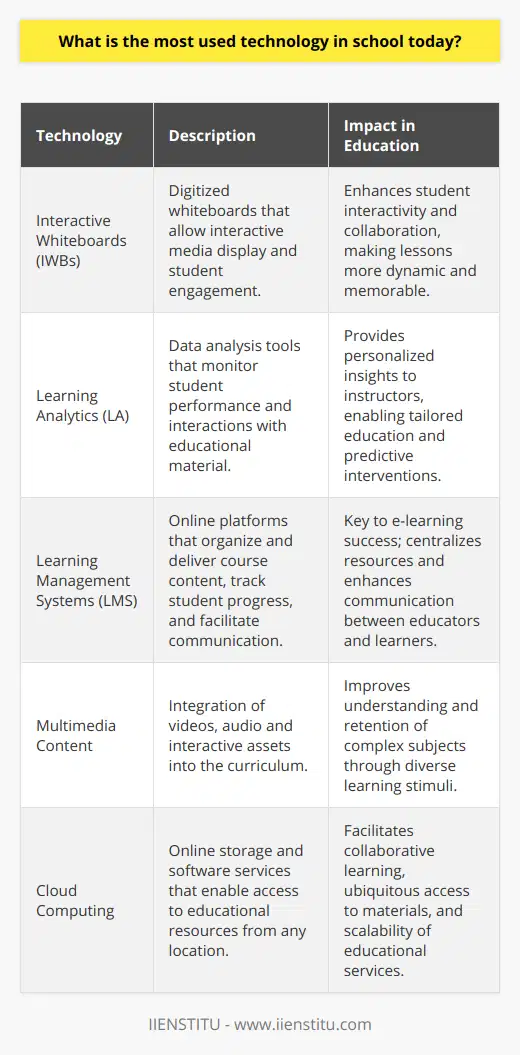
What are the technology trends for learning in the coming years?
Artificial Intelligence (AI)
In the future, Artificial Intelligence will dominate learning technologies. AI gives learning software the ability to adjust to individual learner needs.
Adaptive Learning
Adaptive learning systems offer personalised instruction pathways. They adapt lesson delivery based on the learner's performance, making learning more effective.
Blockchain in Education
Blockchain technology offers secure, immutable records for educational achievements. This will transform certification, ensuring transparency and authenticity.
Augmented Reality (AR) and Virtual Reality (VR)
AR and VR technologies will grow extensively in the learning environment. They provide immersive learning experiences, boosting understanding and retention.
Gamification in Learning
Educational institutions will increasingly adopt gamification strategies. Gamification makes learning exciting by incorporating game elements in lessons.
Mobile Learning
Mobile learning is set to become more prevalent. Its portability and convenience help students learn anytime and anywhere.
Microlearning
Microlearning, a method of teaching in small, focused modules, will also gain popularity. The approach fits perfectly with today's fast-paced world where learners tend to have shorter attention spans.
In summary, the trends highlighted above offer promising opportunities for improved learning. By embracing these technology trends, educators can enhance their teaching methods, thereby enriching the students' learning experience.
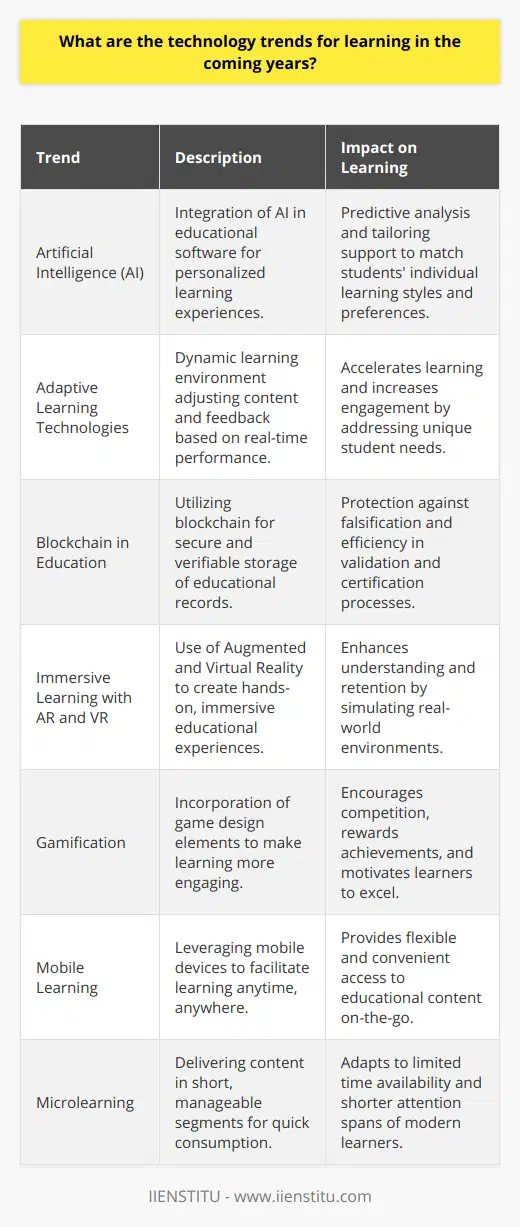
What is the newest technology in education that has the potential to significantly impact student outcomes?
Innovative Technology in Education: Artificial Intelligence
Artificial Intelligence (AI) represents the newest technology in education. It holds great potential to drastically alter student outcomes. AI automates basic tasks, making teaching more efficient.
Efficiency with AI
For instance, with AI, grading of multiple-choice and fill-in-the-blank testing happens instantaneously. This frees up educators to concentrate on comprehensive student engagement and interactive learning.
Individualized Learning with AI
AI also aids in individualized learning. It allows customization of education to match each student's needs and pace. Personalized learning analytics can track progress, identify learning gaps, and suggest tailored interventions.
Interactive Tools: Virtual Reality
Another transformative technology is Virtual Reality (VR). VR facilitates experiential learning, making abstract concepts tangible. For example, VR allows students to explore a replicated ancient city, offering a profound historical understanding.
VR and Real-life Situations
VR can also simulate real-life situations. In medical education, students can use VR to practice surgeries, reducing potential risks in real operations. This practical training enhances skills and confidence.
Enhanced Collaboration: Cloud Computing
Lastly, Cloud Computing promotes collaboration. This technology allows students to work on projects together, irrespective of their location. Shared access to resources effectively facilitates group work, boosting cooperative learning.
In conclusion, Artificial Intelligence, Virtual Reality, and Cloud Computing present groundbreaking shifts in education technology. These tools focus on enhancing teaching efficiency, personalizing education, promoting experiential learning, and fostering collaboration. Ultimately, these advancements can significantly impact student outcomes, offering a promising future for global education.

